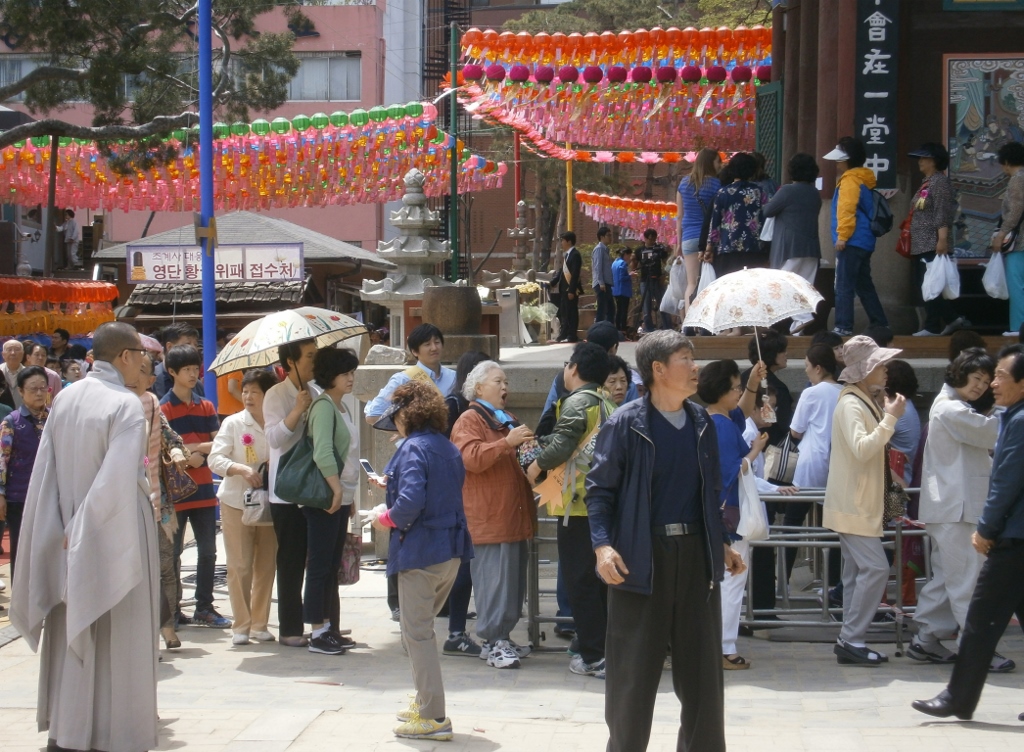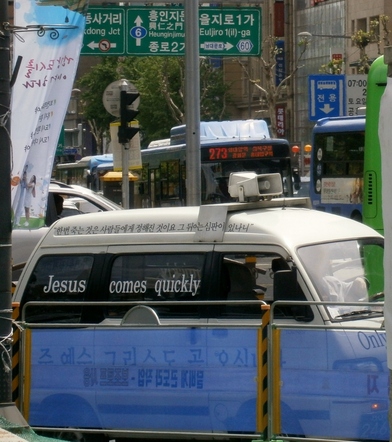As a follow-up to
post-57, there are a couple of other pictures I took on the Buddha’s Birthday holiday that really tell a story when contrasted. First:

At Jo-Gye Temple [조계사], Central Seoul, about midday on Buddha’s Birthday 2013. Koreans are in line
to enter the main temple building which houses a large Buddha. A monk looks on. [Click to enlarge]
The above was at
the Jo-Gye Temple compound in north-central Seoul (the old downtown). It is a major site in the
Jo-Gye Order of Korean Buddhism.
(Incidentally, I see that this denomination officially came together in spring 1962, a year into the Park Chung-Hee era. Did the latter impel the former? General Park declared himself Buddhist. Interestingly, though, according to his recent biography he went to a Protestant church as a boy; later in life gave money to that church.)
I stopped by on Friday, Buddha’s Birthday (석가탄신일). (I was also there in May 2010 with a German man, but that’s a different story…)
Jo-Gye Temple is sort of tucked away. I mean, it’s easy to travel within Seoul for a few days and miss it, if you’re not aware of it. This is not to say it’s small: The compound is quite large; it’s just not overly conspicuous. This befits Buddhism, I suppose. It manages to exude a rather tranquil atmosphere in central Seoul, which is an impressive feat.

Jo-Gye Temple on Buddha’s Birthday 2013.
A wider shot of the crowds waiting to enter the temple. Buddhist prayer-lanterns are above.
Long ago, I didn’t believe the statistics that said South Korea was only “20-25% Buddhist”. Maybe that is the share of active Buddhists. Unfair counting, I thought. I imagined most Koreans were sympathetic to Buddhism as their “ancestral religion” (or something). I imagined most of the population to be nominal Buddhists, as it was
“the old Korean religion” (in my mind) and therefore perhaps connected with Korean racialist-nationalism, an ever-present political current in Korea on “left” and “right”.
My ideas about Buddhism’s place in Korea were all quite wrong.
In fact, my impression from casual observation is that a 20-25% Buddhist population-share seems too high. It may be an accurate figure, but in most parts of the Seoul Megalopolis I am familiar with, Buddhism is almost invisible. Christianity is very visible, which surprises many.
Korea’s complicated religious history is hard to untangle (as is much of Korean history, generally), but the idea that Buddhism is “the old Korean religion” (to which ‘patriots’ adhere) is dubious. In fact, there is arguably much more “racialist-nationalism” from the Christian side in South Korea today.
Now that I know more, I would say the following is true (and this is all anecdotal from my own observations):
(1) Most Koreans are indifferent to Buddhism;
(2) A minority of Koreans are Buddhists or sympathetic to Buddhism;
(3) A larger minority (a % I wouldn’t even hazard to guess of the Christians) is hostile to Buddhism, at some
level, on (what appear to be) religious grounds (though I always suspect there is more to that story);
Point (3) leads me to the “contrasting images”. The above two photos depict the (“pro-“)Buddhist side. The contrast is with an antagonistically-anti-Buddhist side.
A certain kind of Christian was out in force in central-Seoul, taunting the Buddhists. It was something (perhaps) like a group of Muslims in New York City assembling outside a church to mock worshipers entering a church for Easter.
I saw them around Jo-Gye Temple. I presume they were also around other temples. Some had loudspeakers blaring (what I presume to be) anti-Buddhist messages. Others were engaged in other forms of anti-Buddhist activism.
These people are a minor nuisance in many public areas on regular Saturdays, but they were really conspicuous in Seoul on Buddha’s Birthday this year. A small team of them I walked past on the way to Jo-Gye Temple was engaged in a loud group-prayer, led by a man in a hat with mic hooked up to a speaker system. The photo is directly below. The prayer-leader was making impassioned pleas for the heathens to turn from the Devil to Jesus (I presume). His voice was full of emotion. These Christians were protected by police to prevent disturbances. Here they are:

On Buddha’s Birthday 2013: Behind the yellow police fence, Christian evangelists engage in group prayer apparently praying that Buddhists will turn from their false religion. The man in the hat is preaching and leading the group-prayer. Police protect them to prevent fighting. Onlookers (including the photo-taker, me) gawked. [Central-Seoul near Jo-Gye Temple, Buddha’s Birthday 2013]
In case there is any doubt as to whether these Christians were “targeting” the Buddhists, their banner clearly mentions to Korean word for Buddhism (불교). I cannot otherwise figure out what the banner is saying.
Another tactic of the anti-Buddhists was that still-regular-feature-of-Korean-public-life, the “guy in a van blaring messages from a loudspeaker”. Here is a shot of one parked at an intersection, blaring messages.

On Buddha’s Birthday 2013 in central-Seoul,
a Christian evangelist van with a loudspeaker
attached blares anti-Buddhist messages
Finally, I saw the below later in the day. It is not specific to Buddhism. Anyone who spends enough time in central-Seoul sees somebody with this sign, sooner or later. I can’t figure out what he’s trying to say, other than the bottom left message of “Jesus will come soon! Repent!”
Caveat: It would be wrong for someone reading this to assume that Buddha’s Birthday in Seoul was marked by ‘sectarian’ antagonism, which it surely was not. Overall, it was just a regular holiday with people out enjoying a Friday off. Again, most Koreans are indifferent to Buddhism (or so is my impression). Most people of any time and place are indifferent to the “political” struggles going on around them, though. It is significant that a Christian-vs.-Buddhist dynamic is noticeable in South Korea, I think, though what the significance is, exactly, I can’t say for sure.





